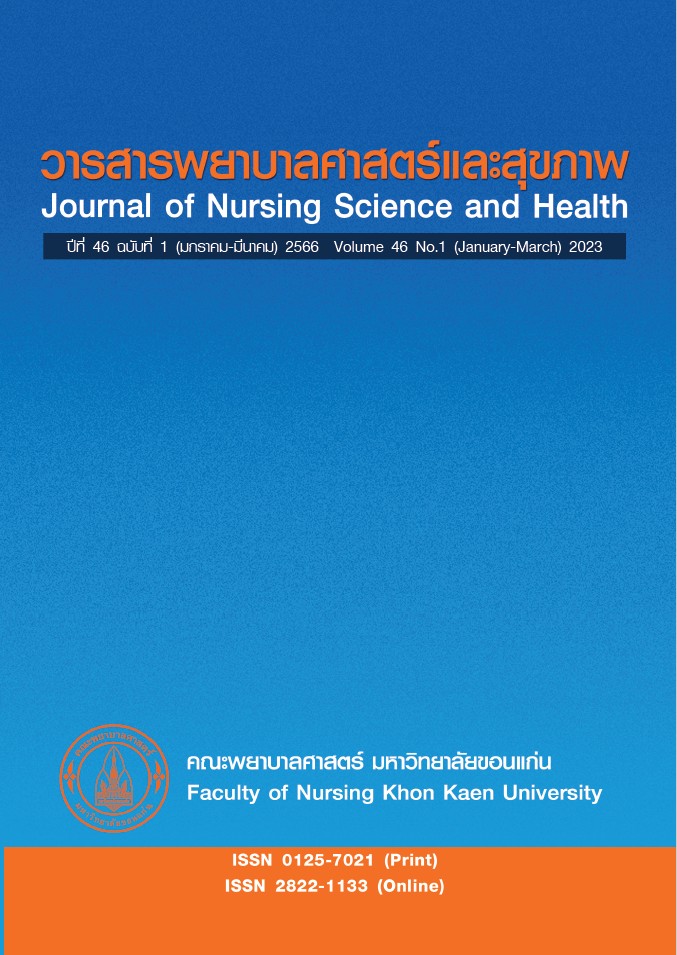การดูแลผู้รับการผ่าตัดกระดูกสันหลังเพื่อป้องกันแผลติดเชื้อ: ผลการศึกษาสถานการณ์ของโรงพยาบาลแห่งหนึ่งในจังหวัดหนองคาย
คำสำคัญ:
การผ่าตัดกระดูกสันหลัง , การติดเชื้อแผลผ่าตัด , การดูแลตนเองบทคัดย่อ
บทความนี้นำเสนอผลการวิจัยซึ่งเป็นส่วนหนึ่งของวิจัยเชิงปฏิบัติการแบบมีส่วนร่วมเรื่องการพัฒนาแนวทางป้องกันแผลติดเชื้อหลังผ่าตัดกระดูกสันหลัง เพื่อแสดงผลของระยะการศึกษาสถานการณ์การดูแลผู้รับการผ่าตัดกระดูกสันหลังในการป้องกันการติดเชื้อของแผลผ่าตัดบริเวณกระดูกสันหลัง ผู้ร่วมโครงการวิจัยเป็นผู้รับการผ่าตัดกระดูกสันหลังจำนวน 15 คน ผู้ดูแลจำนวน 15 คน และเจ้าหน้าที่ทีมสหวิชาชีพจำนวน 15 คน เครื่องมือที่ใช้ในการวิจัยประกอบด้วย แนวทางการสัมภาษณ์เชิงลึก แนวทางการสังเกตแบบมีส่วนร่วมและไม่มีส่วนร่วม เก็บข้อมูลในช่วงเดือนกุมภาพันธ์ - เดือนสิงหาคม พ.ศ. 2565 วิเคราะห์ข้อมูลเชิงปริมาณโดยใช้สถิติเชิงพรรณนา วิเคราะห์ข้อมูลคุณภาพโดยการวิเคราะห์เชิงเนื้อหา
ผลการวิจัยพบว่า สถานการณ์การดูแลผู้รับการผ่าตัดกระดูกสันหลัง โดยแบ่งออกเป็น 3 ส่วน ได้แก่ 1) การจัดการดูแลตนเอง 2) การดูแลของผู้ดูแล และ 3) การดูแลของทีมสหวิชาชีพ และพบปัญหาในการดูแลผู้รับการผ่าตัดกระดูกสันหลัง 3 ประการ ดังนี้ 1) ผู้รับการผ่าตัดกระดูกสันหลังขาดความรู้เกี่ยวกับโรคกระดูกสันหลังทับเส้นประสาท การผ่าตัดกระดูกสันหลัง การดูแลแผลผ่าตัดกระดูกสันหลัง และการปฏิบัติตัวเมื่อกลับไปอยู่ที่บ้าน 2) ญาติหรือผู้ดูแลขาดความรู้เกี่ยวกับโรคกระดูกสันหลังทับเส้นประสาท การผ่าตัดกระดูกสันหลัง การดูแลแผลผ่าตัดกระดูกสันหลัง และการปฏิบัติตัวเมื่อผู้ป่วยกลับไปอยู่ที่บ้านและ3) ขาดแนวทางการติดตามดูแลผู้รับการผ่าตัดกระดูกสันหลังและการติดตามผลการรักษาอย่างต่อเนื่อง ผู้รับการผ่าตัดกระดูกสันหลัง นอกจากนี้ผู้ดูแลยังมีการจัดการดูแลยังไม่เหมาะสม ผลการศึกษานี้จะนำไปสู่การพัฒนาแนวทางการป้องกันแผลติดเชื้อหลังผ่าตัดกระดูกสันหลังต่อไป เพื่อให้ผู้รับการผ่าตัดกระดูกสันหลังได้รับการดูแลที่มีความต่อเนื่องตั้งแต่แรกรับจนกระทั่งจำหน่ายกลับบ้านและมีการติดตามผลการรักษาต่อเนื่อง 2 สัปดาห์หลังการผ่าตัดจนก่อให้เกิดผลดีต่อการฟื้นหายของผู้ป่วยและสามารถดูแลตนเองได้
เอกสารอ้างอิง
Ministry of Public Health. Cause of morbidity by region per 1,000 population [Internet]. 2017 [cited 2022 Feb 1]. Available from: http://bps.ops.moph.go.th/Health information/ statistic54/
Karnget N. Nursing of spine surgery patients: Case studies. 6th National Conference Nakhon Ratchasima College 2019; 2019. (in Thai)
Santiworabutr S. Effects of Self-efficacy Promotion Program on the quality of recovery after surgery and the daily routine of postoperative patient’s Lumbar spine surgery. [dissertation]. Bangkok: Christian University; 2018 (in Thai)
Yoyuenyong C, Srimongkot P. Factors predicting the recovery of activity of daily living functlon in patients undergoing lumbar surgery. JRTAN 2015;16(1):62-9 (in Thai)
Anderson DJ, Podgorny K, Berrios-Torres SI, Bratzler DW, Dellinger EP, Greene L, et al. Strategies to prevent surgical site infections in acute care hospitals: 2014 update. Infection Control and Hospital Epidemiology 2014;35(6):605-27.
Korol E, Johnson K, Waser N, Sifakis F, Jafri H, S Lo, et al. A systematic review of risk factors associated with surgical site infections among surgical patients. Public Library of Science ONE 2013;8(12):e83743.
Rosenthal VD, Richtmann R, Singh S, Apisarnthanarak A, Kubler A, Viet-Hung N, et al. Surgical site infections, international nosocomial infection control consortium report, data summary of 30 countries, 2005-2010. Infection Control and Hospital Epidemiology 2013;34(6):597-604.
Centers for Disease Control and Prevention. Surgical site infection (SSI) Event. Procedure-associated events SSI. [Internet]. 2013 [cited 2022 Feb 20]. Available from: http://www.cdc.gov/nhsn/pdfs/pscmanual/9pscssicurrent.pdf
Tanprasertsuk, S. Working strategies 2018. [Internet]. 2014 [cited 2022 Feb 15]. Available from: http://plan.ddc.moph.go.th.
Shepard J, Ward W, Milstone A, Carlson T, Frederick J, Hadhazy E, et al. Financial impact of surgical site infections on hospitals: the hospital management perspective. JAMA 2013;148(10):907-14.
Badia JM, Casey AL, Petrosillo N, Hudson P, Mitchell S, Crosby C. The impact of surgical site infection on healthcare costs and patient outcomes: A systematic review of the economic and quality of life burden associated with surgical site infections in six European countries. Journal of Hospital Infection 2017;96(1):1-15.
Dana K. The development of family roles in caring for elderly patients with hypertension at a community health center in Maha Sarakham Province [Thesis]. Khon Kaen: Khon Kaen University; 2013.
Sornlob P, Comesorn S, Tangkawanich T. Educational model in changing health behavior to reduce risk on cardiovascular disease for hypertensive patients in community hospital. Humanities and Social Sciences Journal of Pibulsongkram Rajabhat University 2019; 13(1):167-85. (in Thai)
Wiangwalai S. Learning Management. Bangkok: O.S. Print House. 2013. (in Thai)
Duangchan C. Nursing Handoff Communication through the SBAR Technique. JNSU 2020;41:91-103. (in Thai)
Janwithayanuchita I. A development of interprofessional education model by home visit in patients with chronic diseases. JPNC 2021;32(1):150-70. (in Thai)
Chuenkongkaew W. IPE towards Thai Health Team. Annual national health professional education reform forum: ANHPERF; 2016 November 21-22; Bangkok. P. A. Living; 2016. (in Thai)
World Health Organization. Framework for action on interprofessional education and collaborative practice [Internet]. 2016 [cited 2022 Aug 12]. Available from: http://apps.who.int/iris/bitstream/10665/70185/1/WHO_HRH_HPN_10.3_eng.pdf
ดาวน์โหลด
เผยแพร่แล้ว
รูปแบบการอ้างอิง
ฉบับ
ประเภทบทความ
สัญญาอนุญาต
ลิขสิทธิ์ (c) 2023 วารสารพยาบาลศาสตร์และสุขภาพ

อนุญาตภายใต้เงื่อนไข Creative Commons Attribution-NonCommercial-NoDerivatives 4.0 International License.
วารสารพยาบาลศาสตร์และสุขภาพเป็นเจ้าของลิขสิทธิ์ในการเผยแพร่ผลงานที่ตีพิมพ์ห้ามผู้ใดนำบทความที่ได้รับการตีพิมพ์ในวารสารพยาบาลศาสตร์และสุขภาพไปเผยแพร่ในลักษณะต่าง ๆ ดังนี้ การนำบทความไปเผยแพร่ออนไลน์ การถ่ายเอกสารบทความเพื่อกิจกรรมที่ไม่ใช่การเรียนการสอน การส่งบทความไปตีพิมพ์เผยแพร่ที่อื่น ยกเว้นเสียแต่ได้รับอนุญาตจากวารสารพยาบาลศาสตร์และสุขภาพ



